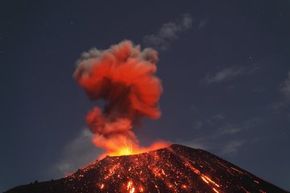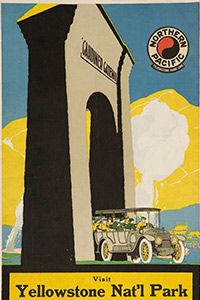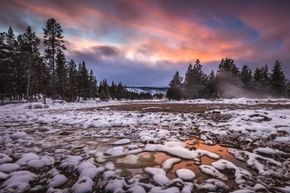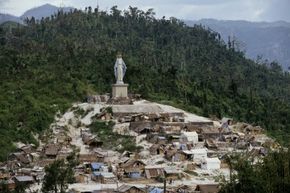In 1883, an Indonesian volcano erupted with the force of several thousand atom bombs, killing an estimated 36,000 people and producing what some call the loudest sound ever heard on Earth [source: Bhatia]. Krakatau (aka Krakatoa) echoed like distant cannon fire over 3,000 miles (4,828 kilometers) of land and ocean. It spewed enough gas and dust skyward to lower the average global temperature by 0.9-1.8 F (0.5-1.0 C) [sources: Geological Society of London; Tharoor]. To this day, its name is synonymous with cataclysm.
Next to a supervolcano, Krakatau is a snap cap. A packet of Pop Rocks.
Advertisement
OK, that's an exaggeration, and better suited to smaller volcanoes. But imagine 50 Krakataus or 1,000 Mount St. Helens erupting in a single location, blasting out as much ejecta in minutes as smaller volcanoes produce in years.
As much as we might fear earthquakes, tsunamis, wildfires and killer storms, in reality only a few natural events pack the power to knock global civilization on its heels. One is a planet-killing meteor. Care to guess the other?
Here's a hint: 74,000 years ago, Krakatau's neighboring island, Sumatra, saw a supereruption that some say nearly wiped out the human race. Although this hypothetical population bottleneck remains the subject of investigation and debate, we do know that the Toba supereruption produced 670 cubic miles (2,800 cubic kilometers) of ejecta, left behind a caldera measuring 19 by 62 miles (30 by 100 kilometers) and possibly jump-started a 10,000-year ice age [sources: Achenbach; Friedman-Rudovsky; Geological Society of London; Marshall; Tyson; USGS].
Scientists have identified around 30-40 supervolcanoes globally, 6-10 of which are potentially active [sources: Friedman-Rudovsky; Marshall]. The last to erupt was near Taupo, New Zealand, 26,000 years ago [sources: WTVY; USGS]. The largest we know of, the Fish Canyon Tuff event in Colorado around 28 million years ago, belched out 1,200 cubic miles (5,000 cubic kilometers) of deposits -- five times the amount usually required to join the volcanic Legion of Boom [source: Geological Society of London].
Today, North America, South America and Asia face the greatest risks of future supereruptions. Europe's only known supervolcano, the Phlegrean Fields area located across the Bay of Naples from Mt. Vesuvius, last erupted 35,000 years ago [source: Geological Society of London].
As we examine supervolcanoes in this article, we'll pay particular attention to the fitfully slumbering giant in the U.S.'s backyard: the hotspot beneath Yellowstone National Park, home to 2-3 supereruptions in the past 2.1 million years [sources: Achenbach; Robinson; Tyson; USGS]. And we'll hope that volcanologists have correctly estimated the frequency of these cataclysms at around one every 100,000 years because, right now, there's not much we can do about them.
Advertisement



